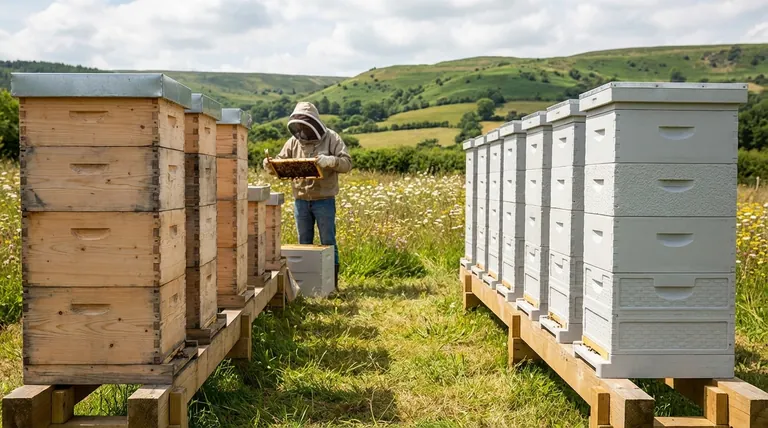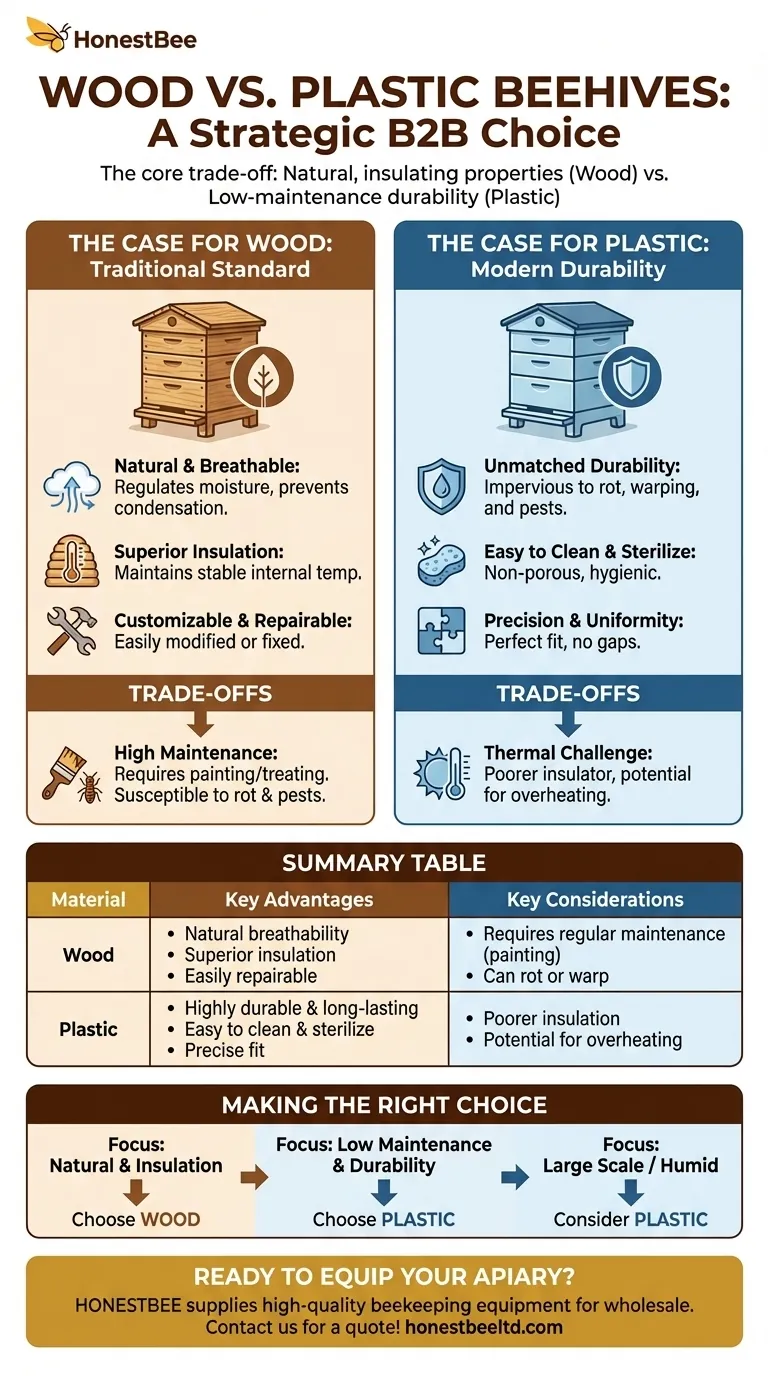When selecting a beehive, the fundamental choice comes down to two primary materials: traditional wood and modern plastic. Wood has been the standard for centuries, valued for its natural properties, while plastic offers a contemporary alternative focused on durability and ease of use. Each material presents a distinct set of advantages and challenges that directly impact hive management, colony health, and the beekeeper's workload.
Your choice between wood and plastic is not a matter of right or wrong, but a strategic decision based on your priorities. The core trade-off is between the natural, insulating properties of wood and the low-maintenance durability of plastic.

The Case for Wood: The Traditional Standard
Wood is the classic material for hive construction, and for many beekeepers, it remains the only choice. Its properties align closely with the natural environments where honeybees build their homes.
Natural and Breathable
Wood is a natural, porous material. This allows it to "breathe," helping regulate moisture and prevent the buildup of excess condensation inside the hive, which can be harmful to the colony.
Superior Insulation
Wood offers excellent natural insulation. This helps the bee colony maintain a stable internal temperature, protecting them from extreme heat in the summer and helping them conserve energy and food stores during the cold winter months.
Customizable and Repairable
Wooden components can be easily modified, repaired, or replaced. A beekeeper can sand down a rough edge, replace a single rotted board, or build custom components, offering a level of flexibility not available with molded plastic.
The Case for Plastic: Modern Durability and Convenience
Plastic hives have gained significant popularity, especially among commercial beekeepers and those seeking to minimize physical labor and maintenance time.
Unmatched Durability
High-density plastics are impervious to rot, warping, and pests like wax moths that can burrow into wood. A plastic hive can withstand years of harsh weather with minimal degradation, offering a longer functional lifespan than an unmaintained wooden hive.
Ease of Cleaning and Sterilization
Plastic's non-porous surface makes it exceptionally easy to clean. It can be scraped, pressure washed, or even bleached to eliminate disease spores like American Foulbrood, a significant advantage for maintaining apiary hygiene.
Precision and Uniformity
Plastic hive components are molded to precise, uniform dimensions. This ensures a perfect fit every time, reducing drafts and preventing bees from building unwanted comb in gaps between boxes, which is a common issue with aging woodenware.
Understanding the Trade-offs
Neither material is perfect. Acknowledging the downsides of each is critical for making an informed decision that aligns with your goals and local climate.
The Maintenance Burden of Wood
The primary drawback of wood is its need for regular maintenance. It must be painted or treated to protect it from the elements, and it will eventually degrade, requiring repairs or replacement.
The Thermal Challenge of Plastic
Plastic is a poorer insulator than wood. In very hot climates, plastic hives can overheat, and in cold climates, the colony must consume more honey to generate the heat needed to survive the winter. Some beekeepers also report that bees are slower to draw out comb on plastic foundations compared to natural beeswax-coated ones.
Cost and Long-Term Value
Initially, a wooden hive is often cheaper than a comparable plastic one. However, when you factor in the cost of paint, labor, and eventual replacement due to rot or damage, the long-term cost of plastic may be lower due to its superior durability.
Making the Right Choice for Your Apiary
The ideal material depends entirely on your beekeeping philosophy, budget, and the amount of time you can dedicate to maintenance.
- If your primary focus is a natural environment and optimal insulation: Choose wood for its breathability and superior thermal properties, which more closely mimic a tree hollow.
- If your primary focus is low maintenance, durability, and ease of sterilization: Choose plastic to minimize your workload and maximize the lifespan of your equipment.
- If you are managing a large number of hives or live in a very humid climate: Seriously consider plastic for its longevity, uniform components, and resistance to rot.
Ultimately, the best hive is the one that allows you to be an attentive and effective steward for your bees.
Summary Table:
| Material | Key Advantages | Key Considerations |
|---|---|---|
| Wood | Natural breathability, Superior insulation, Easily repairable | Requires regular maintenance (painting), Can rot or warp over time |
| Plastic | Highly durable & long-lasting, Easy to clean & sterilize, Precise, uniform fit | Poorer insulation, Potential for overheating in hot climates |
Ready to equip your apiary with the right hives?
Whether you manage a commercial operation or are a distributor sourcing reliable equipment, the choice between durable plastic and traditional wooden hives is critical for your success. At HONESTBEE, we supply a full range of high-quality beekeeping supplies and equipment through our wholesale-focused operations, helping commercial apiaries and distributors build efficient, productive operations.
Let our expertise guide you to the best solution for your specific climate and management style. Contact HONESTBEE today to discuss your needs and request a wholesale quote!
Visual Guide

Related Products
- Langstroth Bee Hives Bee Keeping Box for Beginners Beekeeping
- Wholesales Dadant Size Wooden Bee Hives for Beekeeping
- Professional Insulated Plastic Bee Hives
- HONESTBEE Professional Long Handled Hive Tool with Precision Cutting Blade
- Long Langstroth Style Horizontal Top Bar Hive for Wholesale
People Also Ask
- Should a beginner try a different type of hive? Start with a Langstroth for a solid foundation.
- Why were wooden hives traditionally preferred? For Natural Beekeeping Aligned with Bee Biology
- What basic equipment is needed to start beekeeping? Your Essential Guide to a Confident Start
- How does the orientation of the hive sides benefit comb construction? Ensure Straight, Movable Combs for Easier Hive Management
- What is the best type of bee hive for beginners? Start with the Proven Langstroth Standard



















